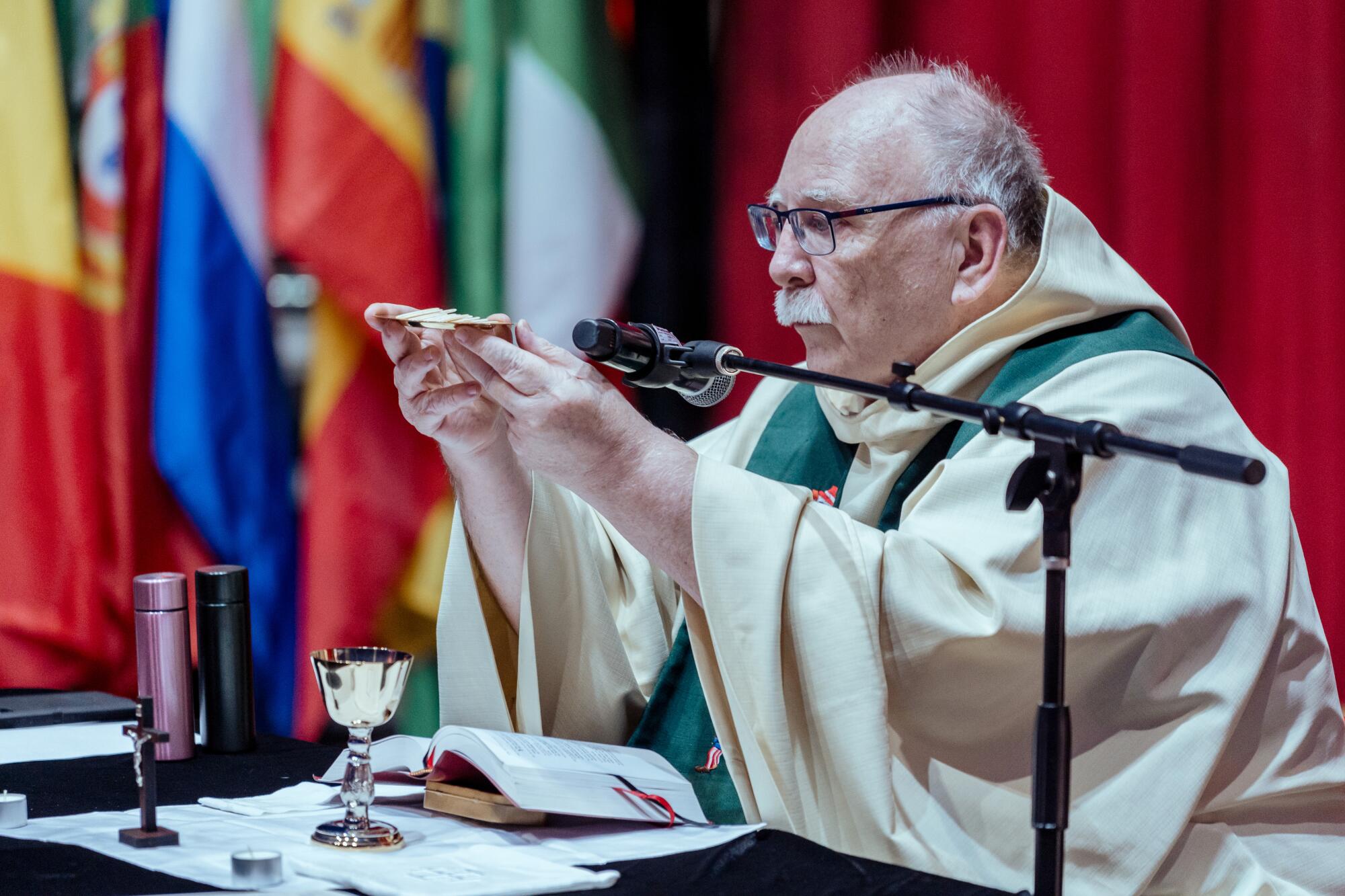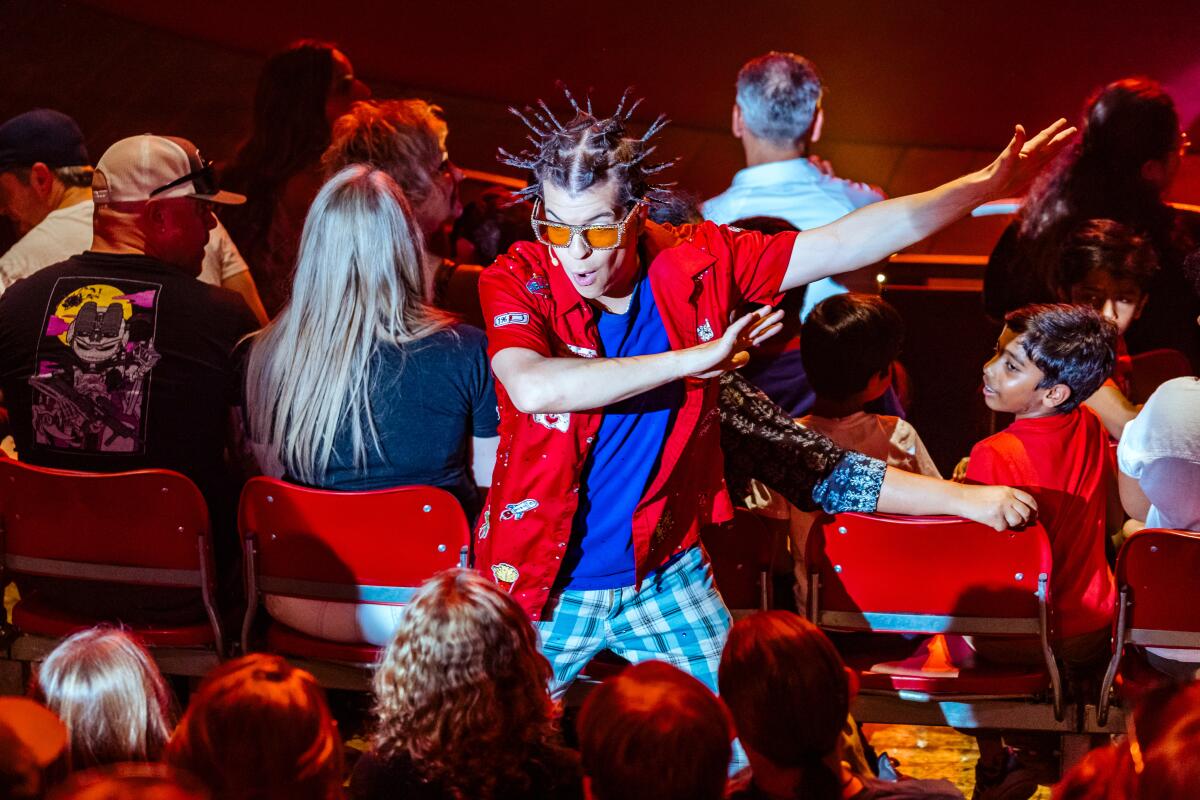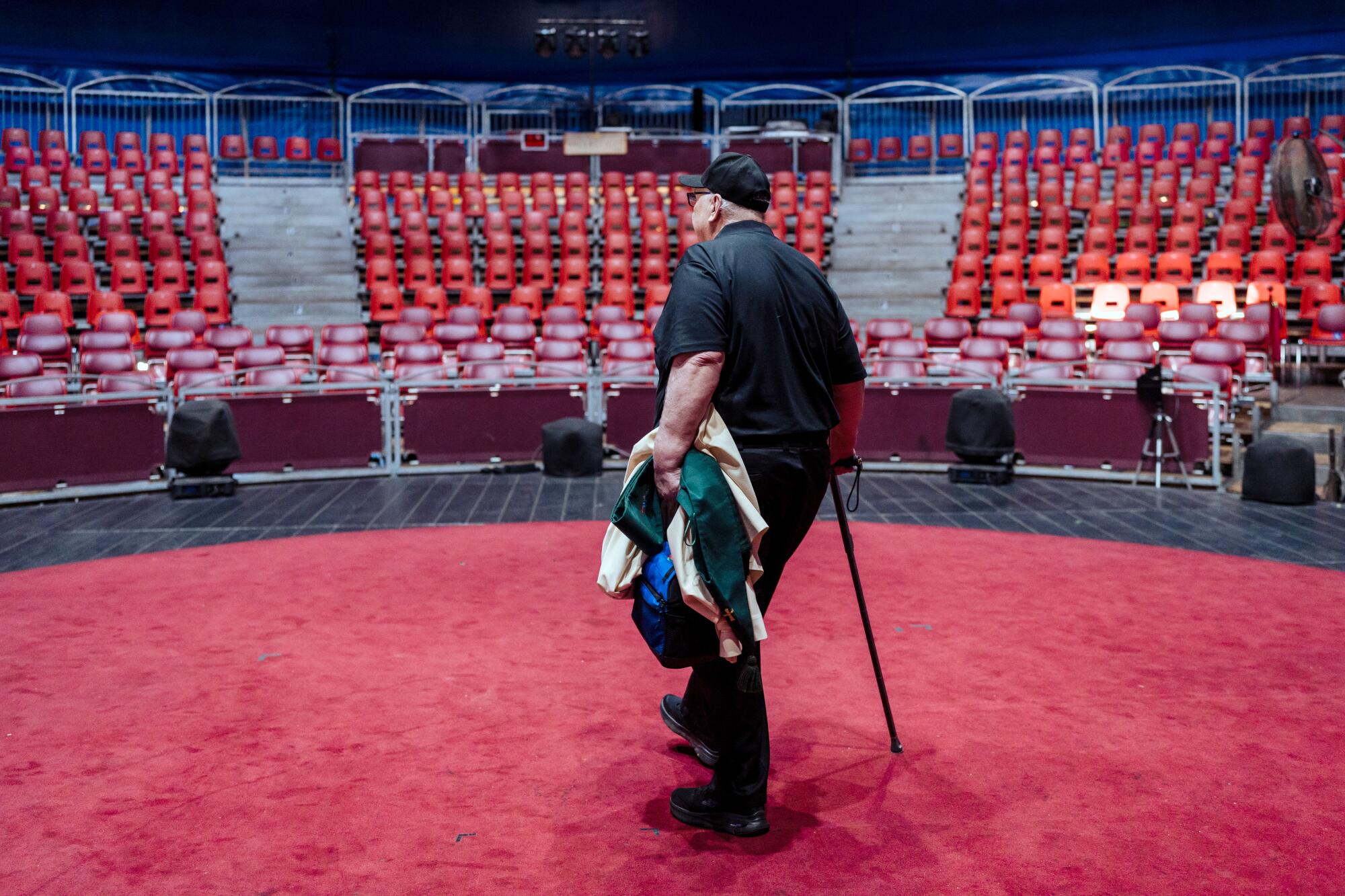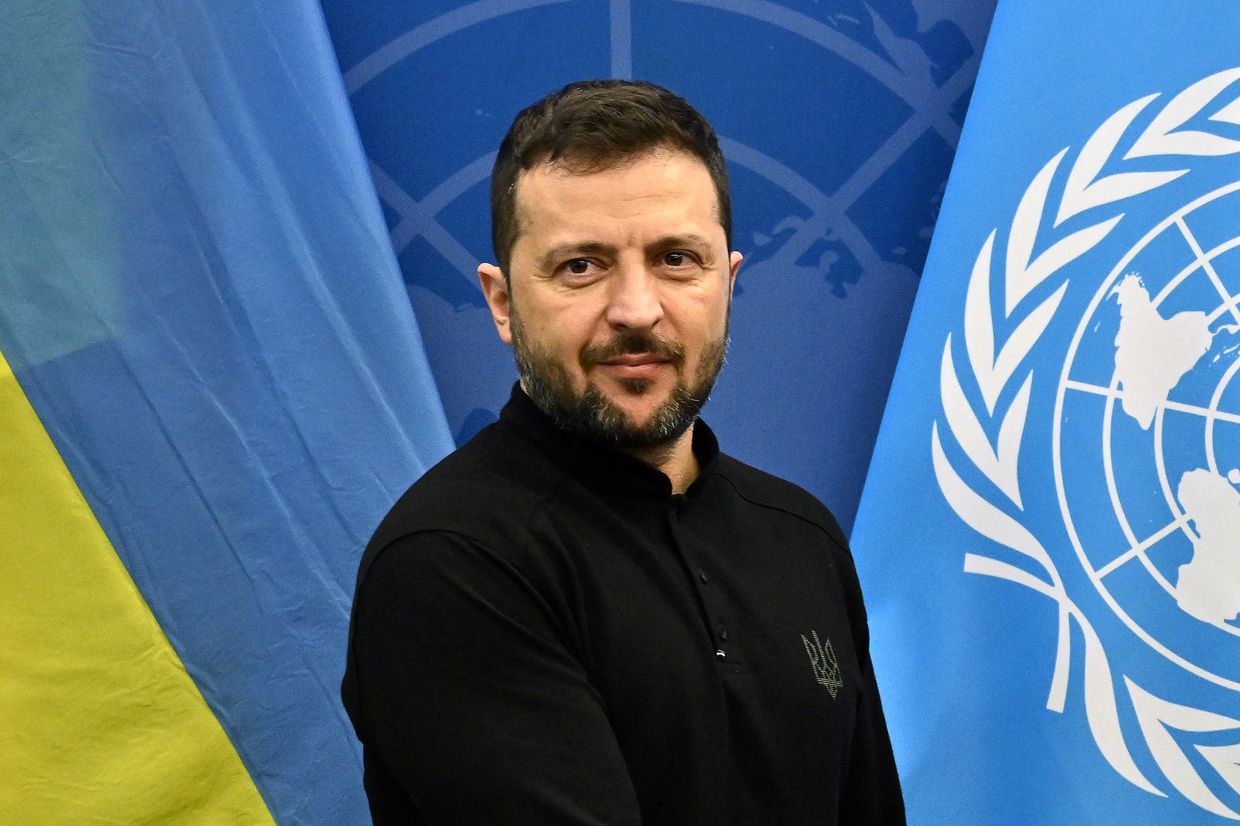Lifestyle
This daredevil has one of the most dangerous jobs. His priest is on standby

• Fifth-generation circus performer Daniel Eguino is guided by his focus and his faith as he performs inside the locked metal cage known as the Globe of Steel at Circus Vargas.
• A Sunday with the “most unique congregation on Earth”: from the jugglers to the flying trapeze artists to the daredevils — and Father Frank, their clown-turned-chaplain.
It’s almost 11 a.m. on a Sunday in early September, and it’s already 103 degrees here. Around 20 jugglers, trapeze artists and concession stand workers are filtering into the big top that the majestic Circus Vargas uses to perform across 25 California cities 11 months out of the year.
Seated in red chairs arranged in neat rows inside the ring, these members of the circus community have gathered to attend Mass, an optional circus tradition that happens at least once a year. In the space under the tent, you can see popcorn spilled from the previous day’s slate of three shows.
In the front row sits Daniel Eguino, 36, a daredevil who rides the Globe of Steel, or, as it’s also known in the circus world, the Globe of Death. For the act, Eguino and three other motorcyclists swoop about inside an 18-foot-high locked steel cage at speeds of up to 60 miles an hour, thrilling the watching crowds.
Father Frank Cancro leads Mass at Circus Vargas on Sept. 8 in Folsom, Calif., for a group of circus workers that includes jugglers, trapeze artists and concession stand workers.
On his lap is his wide-eyed 1-year-old daughter, Natasha, and next to him is his wife of eight years, Thatiana Fischer, 35. The two, who have been with Vargas for three years, met when they were with Ringling Bros. and Barnum & Bailey. She’s a jazz dancer working as a “line manager” — someone who helps performers retain choreography — for Vargas, and appears in three acts, along with ushering.
Earlier that morning, Father Frank Cancro, 74, the National Circus Chaplain, laid out water, wine, communion wafers and a cross on a folding table adorned with a black tablecloth. Cancro is a former clown turned retired priest turned chaplain, appointed by the United States Conference of Catholic Bishops Circus and Traveling Shows Ministry, which dates back 100 years and serves more than 50 circuses around the world. For the past 15 years, he’s been going on the road with circuses to preside over Mass, perform sacraments and provide pastoral care. He doesn’t earn a salary and lives off his diocese retirement and special collections.
Serving what he calls the “most unique congregation on Earth,” he caters to the “spiritual and personal needs of all those who travel down the road without a ZIP Code.”
With his priest stole decorated with embroidered clowns, Cancro is part minister, part grandparent, part therapist and part human resources professional for a population that research shows can struggle with their mental health. (He sees two to three suicides per year in his work as circus chaplain, he says.)

Father Frank Cancro during Mass.
Eguino, Fischer and Cancro have been friends for years. In 2017, the priest assisted with the couple’s Holy Communion and confirmation; when he’s not traveling with them, he stays in touch via the Meta platform Messenger. For Eguino and Fischer, his presence brings comfort. “Sometimes it’s only 20 minutes, but the words he says during the Mass, sometimes it’s all we need to hear in that moment,” said Fischer.
Back under the tent, small fans around the ring blow cool air on the intimate group. Flying trapeze artist Mariella Arata-Quiroga, daughter of Nelson Quiroga and Katya Arata-Quiroga, Vargas owners and longtime friends of Cancro, turns to smile at her grandfather, Victor Arata, a retired high-wire performer. The Faltyny family from the Czech Republic, who perform as jugglers and unicyclists, look on contently.
Cancro preaches embracing wholeness — in other words, health, happiness and belonging — while on the road. He teaches from the book of Mark, telling the story of Jesus’ journey to Decapolis, where he restored a deaf man’s hearing and ability to speak, a physical healing signaling awe. When circus-goers witness acts like a triple somersault on the trapeze or spinning in a human hamster wheel without a harness, they see a fleeting moment that is said to have divine impact. “There’s an opportunity for people to see the reality of God’s presence and God’s face in you,” Cancro tells the group.
Eguino, who says he was “born in the circus,” with five generations of his family performing, has worked in the Globe for the last 21 years — first in the Argentine circuses where he grew up, then in America starting in 2007. The son of a contortionist mother and a Globe of Steel rider father, Eguino has a tattoo of the steel cage on his left forearm along with a $100 bill, representing the act as his livelihood.
The Globe of Steel is also informally considered one of the 10 most dangerous circus acts, along with fire breathing and sword swallowing. Eguino knows of riders from Brazil and Colombia who have died or faced near-death experiences. Globe accidents were reported in Russia and the U.S. in 2015 and in the U.K. in 2018.
“My act is very dangerous,” Eguino says. He doesn’t like to talk about the accidents for fear people will judge him for continuing in his line of work. Instead, he emphasizes safety, practice, equipment maintenance, trust between riders and focus. And he relies on his faith to ground him: “After the Mass, I feel like I am protected. I feel more comfortable to do everything.”
Nearly 10 years ago, Cancro performed the anointing of the sick — laying hands on a person who is ill, spreading oil on their forehead and praying — on Eguino. The sacrament is often associated with end-of-life care, but in the circus it can occur in the context of accidents. Eguino was in the hospital awaiting surgery after breaking his jaw during practice at the Bradenton, Fla., winter quarters of Feld Entertainment, the company that owns Ringling. As Eguino recovered, no other rider would enter the Globe for fear of getting hurt. Cancro blessed it, sprinkling holy water both inside and out.
Under the tent, Cancro asks the crowd, “Is there anything or anyone someone wants to pray for? Just shout it out.”

Father Frank Cancro speaks with Daniel Eguino, holding Natasha, and Thatiana Fischer.
At first, silence follows. In a middle row, Ringmaster Johnathan Lee Iverson, who has known Cancro for two decades, and his wife, Priscilla Iverson, a dancer turned show liaison, hold hands.
One by one, people stand to offer requests.
“I want to pray for Larry, a visitor to the circus every year in Escondido, who I would chat with often. He knew many performers’ names. He passed away in April, and I just found out,” says juggler and unicyclist Emil Faltyny.
“I pray for a member of the circus community who is in the hospital,” Fischer says.
Following the 40-minute service, a sense of jubilation fills the tent.
“Today I feel very happy,” Eguino says. “It was the first Mass with my child.” During the service, Natasha had been seated on her father’s lap without a peep until the very end, when she spotted Arata’s dog and had to say hello. Afterward, she waddles through the ringside seating in her white and pink sparkly sneakers.
By the time the doors open at 2 p.m. for the show, Fischer is in her polyester usher uniform, helping audience members to their seats.

Attendees buy refreshments before entering the Circus Vargas tent.
By 2:15 p.m., she is dressed in a green gown with a fruit headdress on her head, representing her home country of Brazil, for the opening act: a roll call in which costumed performers greet the audience with song and dance introducing the 13 countries — from Italy to Bulgaria — they collectively represent.
By 3:30 p.m., the Globe riders are warming up, stretching and playing a quick game of pingpong at a table behind the tent.
At 3:40 p.m., the four motorcyclists head to their truck to claim their bikes and don chest protectors, heavy-duty knee-high boots, knee pads and bedazzled helmets. In selecting their matching white-and-gold outfits, Eguino, who is in charge of costumes, was inspired by Tommy from the Power Rangers franchise.
Backstage, Eguino leans his body against his motorcycle and closes his eyes for a quick prayer. Growing up in Argentina, faith was always a part of his life, he says, but it’s deepened as he’s grown closer to Cancro.
Fischer whispers “good luck” in her husband’s ear, and they kiss.

Daniel Eguino kisses his wife, Thatiana Fischer, before the Globe of Steel act.
“Are you ready?” the ringmaster roars from inside the tent.
On his bike backstage, Eguino steps on the gas twice.
Techno music plays as the riders enter the stage. Sweat is visible on their faces. Some 900 attendees stare, rapt, as the daredevils loop and arc on their bikes, the wheels illuminated. The tent is immersed in a deafening motorcycle hum. A mere arm’s length from one another, the riders stay steady, thanks to centripetal force and prayers.
1

2

3

4

1. Circus performer Steve Caveagna entertains the crowd. 2. Daniel Eguino circles the ring holding Argentina’s flag. 3. Patrick and Josue Marinelli brave the spinning Wheel of Destiny. 4. A vendor sells cotton candy before the performances begin.
After five minutes, the riders come to a halt. A crew member opens the Globe’s gate, and Fischer enters the ring, handing a flag to each rider — Bulgaria for Lyubo Karamitrev, leader of the act; Colombia for Neker Mesa; Mexico for Tony Vetty; and Argentina for her husband. The riders circle the ring on their bikes, waving their flags and beaming with pride as the audience roars.
As the stage crew rolls the Globe out of the tent, the riders exit the ring, lingering by the large fan set up backstage. They’ll appear in the last act, when the whole cast sings “We Are One.” Then there’s a short break before the next show starts at 5:30 p.m.
Around intermission of the second show of the day, about a half-hour until the Globe of Death act, the sun sets over the lot in Folsom. Dressed in sweat-shorts and a T-shirt, with a calmness incongruous with his upcoming performance, Eguino sits on his patio. The air has cooled to below 100 degrees for the first time all week.
Fischer steps out of the trailer in a sundress, holding a baby monitor showing a sleeping Natasha. Cancro joins her and Eguino in their outdoor living room, where they talk about the next sacrament the family wants to tackle. Fellow Globe rider Mesa has a 5-month-old baby, and the families are considering a joint baptism. In 2019, Circus Vargas hosted six baptisms and six confirmations in one ceremony. Cancro tells the couple he’ll come back anytime to do it.
Eguino and Fischer express contentment with life, although they have had some struggles with finances. Working as independent contractors who aren’t reimbursed for travel expenses, making enough for groceries, clothing, the dogs (the couple have a Yorkie, a Maltese and a husky), the truck and the costs involved with having a baby can be a challenge. Fuel for the trailer, which they live in throughout the year — sometimes taking it on the road during their month off in December — can be particularly burdensome. They’re also navigating the constant transformation that comes with a new baby.

Father Frank Cancro exits the tent after leading Mass at Circus Vargas.
All three of them stare into the baby monitor as Natasha stirs but doesn’t wake.
“Father, can you give us a prayer before I go?” Eguino asks.
The three hold hands as Cancro prays for protection for the family. Fischer tears up at the mention of her daughter’s name, explaining she’s often emotional, whether it’s a sad movie or a visit with the circus priest. Eguino smiles and stands to go suit up for his last ride of the day.
Without really knowing it, every circus attendee shows up to see if the juggler will keep the balls in the air, if the flying trapeze artist will catch their partner, if the rider will survive the Globe. Today, with a little faith, Eguino emerges unscathed and ready for his next high-stakes ride.
Catch Circus Vargas in SoCal
Santa Clarita: Valencia Town Center, 24201 Valencia Blvd., Santa Clarita, through Sept. 23
Woodland Hills: The Promenade mall, CA-27 and Erwin Street, Los Angeles, Sept. 27-Oct. 14
Torrance: Del Amo Fashion Center, 3525 W. Carson St., Torrance, Oct. 18-Nov. 4
Get tickets and more information here.
This story was supported by a grant from the Chaplaincy Innovation Lab at Brandeis University in partnership with Templeton Religion Trust.

Lifestyle
Video: Why Oakland Is Saying Goodbye to Pro Baseball

The Major League Baseball team the Athletics played their final games this week in the Oakland Coliseum, which has been their home base in California for the past half-century. They’re expected to relocate to Las Vegas for 2028 at the whim of their billionaire owner, John Fisher, and in the meantime play in a minor-league ballpark in Sacramento. Jack Nicas of The New York Times explains how the plan to build a stadium in Las Vegas is driven by a single factor — money — and what it’s meant to Oakland.
Lifestyle
Where to get free trees in Los Angeles and Orange counties

Once upon a time — well, in 1928, actually — the city of Los Angeles took the progressive step of opening the Commonwealth Nursery in Griffith Park, which over the next 50 years grew millions of trees and plants — many propagated from native seeds — for the city’s parks and public buildings.
The nursery closed in the mid-1970s and fell into disrepair, but now the city and its partners are trying to resurrect at least a portion of it to grow native trees for Los Angeles residents to plant for free in their yards.
For more than 50 years, Los Angeles’ historic Commonwealth Nursery in Griffith Park grew millions of plants for the city’s parks and public spaces, but the 12-acre nursery fell into disrepair after it closed in the mid-1970s, as this ruined greenhouse overrun with vines attests.
(Jeanette Marantos / Los Angeles Times)
The Commonwealth Nursery project, led by the city’s nonprofit contractor City Plants, and its staffing partner, the LA Conservation Corps, is just one piece of a much larger regional campaign by utilities and municipalities to increase the urban canopy of trees around greater Los Angeles, bringing beauty, shade and energy savings to city neighborhoods while expanding habitat for birds, insects and other wildlife.
That campaign involves planting trees in parkways and along streets. Many jurisdictions are also providing free trees to residents to plant in their yards, along with instructions and other support.

One of the old greenhouses at Commonwealth Nursery, with its roof partially caved in by a large fallen eucalyptus branch.
(Jeanette Marantos / Los Angeles Times)
The program doesn’t just beautify treeless neighborhoods, said arborist Carlos Campero, executive director of the City Plants program; it also reduces energy use. A strategically planted deciduous tree can cool a house during the hottest months, reducing air-conditioning needs, and provide warmth from the sun in the winter, when it drops its leaves, to reduce heating costs as well. City Plants offers an online tool to help residents find the best location for planting trees on their property to maximize their energy savings.
That buy-in makes all the difference in encouraging property owners to plant more trees, said Matthew Wells, public landscape manager for the city of Santa Monica, which began its tree giveaway program as an experiment in 2023.
The response was so enthusiastic, Wells said, that the city has more than doubled the number of trees it plans to give away this fall and next spring, from 150 to 400, and once again, it’s including fruit trees and smaller trees that can live on a balcony, because so many of the city’s residents are renters who live in small spaces.

City Plants’ fledgling native plant nursery fills a small corner of the Commonwealth Nursery’s terraced — and mostly unused — growing areas.
(Jeanette Marantos / Los Angeles Times)
Like other jurisdictions, Santa Monica provides lots of instructions to help ensure the trees survive. “For many people, this might be the first tree they’ve ever planted, so we want them to know how to look after it,” Wells said. “We don’t want it to be like, ‘Somebody gave me a goldfish and I killed it within a month. And I’ve never had a pet again.’”
Most jurisdictions, including the city of Los Angeles, are getting their giveaway yard trees from wholesale nurseries. But nursery manager Amanda Bashir Chaves said City Plants is trying to increase its native tree offerings by collecting seeds (with permission) from Griffith Park and other locations and then raising those plants in a small section of the Commonwealth Nursery — a project it hopes can expand with time.
The 12-acre nursery grew more than 500,000 plants the first year it opened in 1928, according to a history by the Friends of Griffith Park, and between 1 million to 2 million plants annually after that, while providing jobs for some 45 people. An acre-sized lath house provided shade for tender seedlings, and an innovative rainwater collection system provided water for irrigation six months of the year. Acres of terraced growing areas and multiple greenhouses produced many native plants grown from seed collected around the park such as sumacs, ceanothus, yellow-blooming flannel bush, manzanitas, barberries, monkeyflowers, Catalina cherry, toyon and coffeeberry.

Nursery manager Amanda Bashir Chaves holds up a native California buckeye sapling she grew from seed at the City Plants’ Commonwealth Nursery.
(Jeanette Marantos / Los Angeles Times)

LA Conservation Corps workers Gia Hernandez, in the orange vest, and Lorenzo Chavez planting Cleveland sage seeds at the Commonwealth Nursery.
(Jeanette Marantos / Los Angeles Times)
“In one planting bed alone, 75,000 coast live oaks were growing from locally collected acorns, a sight which astonished and amazed the 500 park employees who attended the nursery’s official grand opening in 1928,” according to the history.
It all came to an end after the passage of Proposition 13 in 1978, which limited property taxes to 1% of assessed values and more than halved property tax revenues overnight. “Budget cuts made supporting the facility and its staff untenable,” according to the history, “and as a result, the nursery fell into great disrepair.”
Today, the greenhouses are overgrown with leftover plants, their roofs smashed by giant fallen eucalyptus branches. It’s not clear what will happen to those ruined greenhouses, but Chaves and Campero hope their nursery can expand to grow large native shrubs like toyon and lemonade berry, as well as some of the non-invasive, non-native trees offered to residents, in the large unused terraced growing areas at the site, Chaves said.
More plants could mean more jobs for the LA Conservation Corps, which contracts with the city to grow and distribute trees under the City Plants program, Chaves said. So far, Chaves has been running the nursery herself, with the assistance of two Conservation Corps members, Lorenzo Chavez and Gia Hernandez, who help with the time-consuming work of planting seeds and separating seedlings into their own pots.
How to get a free tree
In almost all cases, you must be a customer of the utility and/or resident of the municipality. Some entities, like City Plants, offer trees throughout the year, depending on availability.
Others have giveaways timed to specific dates or events. Southern California Edison, for instance, offers free trees to some customers through a partnership with the Arbor Day Foundation’s Community Canopy and Energy-Saving Trees programs. Trees go quickly, but you can join SCE’s wait list or subscribe to the foundation’s newsletter to be informed of upcoming giveaways in other locations, said program manager Kristen Bousquet.
Some utilities, such as the Metropolitan Water District of Southern California, offer rebates on electric bills to customers who purchase trees.

The LA Conservation Corps, which contracts with City Plants to grow native trees at Commonwealth Nursery, is growing some endangered varieties as well, such as Southern California black walnut seedlings, left, and Engelmann oak seedlings.
(Jeanette Marantos / Los Angeles Times)
Note, too, that while Los Angeles County and several municipalities may not provide free yard trees — the county spends almost all of its $20 million budget for trees on trimming or otherwise maintaining its 170,000 street trees, said Deputy Director of Transportation Steve Burger — they will take requests to add trees to parkways in front of homes. If you live in a county-maintained neighborhood, you can fill out an online form to request that Los Angeles County Public Works plant a parkway tree.
If you don’t see your jurisdiction, contact your local municipality or power provider to find out if they offer a free yard tree program.
Tree giveaway programs
Anaheim TreePower Residential Program is a partnership between Anaheim Public Utilities and Anaheim Community Services that provides up to six free trees to be delivered to the homes of utilities customers, who can choose their trees from a catalog of nearly 50 species. Customers must sign a planting agreement and work with a TreePower representative to find the best location on their property for their trees. Customers may also purchase up to three 5-gallon trees from the nursery of their choice and get a $20 rebate per tree. The mature height of rebate trees cannot exceed 25 feet.
Altadena Heritage Committee is offering one free 15-gallon tree for residents who place a request by Oct. 15. Pickup is on Nov. 16. Five species are available: Western sycamore, Chinese flame tree, California pepper, pink trumpet tree and pink dawn chitalpa.
Burbank Water & Power, in partnership with the Arbor Day Foundation, provides up to three free trees for Burbank residents and 20 trees for Burbank businesses.
Glendale Water & Power Tree Power offers customers up to three free shade trees on a first-come-first-served basis (single family homes only). Customers can call the city’s arborist at (818) 957-4425 to participate or fill out a form online. Trees will be delivered with stakes, ties, arbor guards and an instructional DVD on tree planting and maintenance.
Grow Monrovia, a nonprofit community nursery and gardens on the grounds of the Maryknoll Sisters retirement home, is providing free oak saplings to residents of Foothills communities from Pasadena to Glendora on Oct. 7, 16, 21 and 28. Giveaway events start at 5 p.m. except on Oct. 16, when the event begins at 10 a.m.; events will feature presentations about the benefits of oak trees and how to care for them. Grow Monrovia offers tree giveaways and planting activities throughout the year.
Long Beach Tree Planting Program provides Long Beach residents with a free tree for their parkway area only (the strip of ground between the sidewalk and the curb). Wait times are typically two months or longer, and tree planting is paused between July and September due to the heat. Residents can request a tree from a list of nearly 50 available species.
Los Angeles City Plants provides up to seven free shade trees for city residents through this partnership between the city and the LA Conservation Corps. Residents can choose from a list of about 30 water-efficient species. City Plants offers regular tree giveaway events (sign up to be notified about upcoming events); you can also order trees online and have them delivered. Free trees are available for schools, businesses and apartment owners as well. Unsure whether you live in the city limits? Enter your address on the website to confirm eligibility. City Plants plants street trees in parkways at the request of residents or neighborhoods, but due to high demand, has temporarily paused that part of its program until it can complete earlier requests.
Los Angeles County does not provide free yard trees but does accept requests from county residents to plant street trees in the parkways in front of their homes.
Metropolitan Water District of Southern California offers rebates — applied to customer utility bills — of $100 per tree for up to five trees for customers who remove their turf lawns and plant trees as part of their new landscape plans.
Pasadena Water & Power Shade Trees Rebate offers a $25 rebate on shade trees purchased by utility customers for residential yards or businesses, and an extra $5 rebate if the trees were purchased in Pasadena. Trees must be at least 2-gallon size and be planted in the ground along the south- and/or west-facing walls of your home or business. Participants must purchase trees from the utility’s approved list of more than 30 species. Residents in the utility’s income-qualified bill payment assistance program get an additional $25 bonus per tree. Customers are limited to 10 trees every five years.
Santa Monica began a free tree giveaway for residents last year with 150 fruit and shade trees, which were quickly snatched up. This fall, winter and spring the city plans to increase its overall offerings to 400 trees, including trees that can be grown in containers, according to Public Landscape Manager Matthew Wells. Tree varieties include Eureka lemon, pink guava, Golden Delicious apple, coast live oak, olive, crape myrtle, California sycamore, desert willow and torrey pines. For giveaway details, follow Santa Monica on Instagram or visit the city’s events page.
Torrance residents can request that the city plant a street tree in the parkway in front of their home. The city plants an average of 400 street trees a year in its parkways, according to the website.
TreePeople is working with multiple jurisdictions in Los Angeles, Riverside and San Bernardino counties to plant more trees, and periodically offers free tree giveaways to residents of those communities, such as the 200 fruit trees it is offering Pacoima residents from 8 a.m. to 4 p.m. Oct. 12 at El Nido Farmer’s Market. Check TreePeople’s calendar or sign up for a newsletter to find out about upcoming events.
Lifestyle
How a catchy tune became the soundtrack to TikTok's silliest videos

MIDI inputs in Logic for the song Monkeys Spinning Monkeys taken from Kevin MacLeod’s Youtube channel. Unlike other artists who seek to protect the rights to their creative work, McLeod encourages anyone to use his music for free. “I just want my stuff to be heard,” he says.
Kevin MacLeod/YouTube/Screenshot for NPR
hide caption
toggle caption
Kevin MacLeod/YouTube/Screenshot for NPR
Turn to TikTok for some amusement, and you’ll find short videos of a fluffy cat cuddling a fluffy dog, a toddler clutching a bag of Doritos as though it were a teddy bear, or a penguin creating flipper-print artwork.
You’ll have to turn up the volume to hear what all these posts have in common: a song created ten years ago called “Monkeys Spinning Monkeys” by Kevin MacLeod.
Although few people know the name of the song or the person who composed it, over the past decade, it’s served as the background music for millions of TikToks and has been played billions of times. It’s also all over Instagram and YouTube.
The song’s story illustrates one of the core ways that music and social media have shaped each other over the last decade—with the proliferation of viral, loopable songs that immediately telegraph a video’s mood on digital platforms designed for ease of copying sound from video to video.
The man behind the monkeys
Kevin MacLeod is a prolific composer who got his start as a computer programmer. He created songs for fun on his computer and in front of audiences at improv comedy shows.
MacLeod’s compositions are what’s known as “library music,” stockpiles of songs that content creators draw upon to score their works. These are the sort of melodies that you would never queue up on Spotify but end up in the background of all sorts of things: video games, films, and countless short videos.
“Usually, I’ll be like watching a YouTube video and the music sucks,” says MacLeod. “And I’m like, well, let me try to do something better.”
And once he tries his hand at something better, he releases it for free.

In the early days of his career, MacLeod would craft his own licenses — not to protect his rights, but to give them away. MacLeod says his approach was to “find a license, and then do everything the opposite,” adding clauses like “you have the right to use this for your personal things. You have the right to use this commercially. You can sell this thing in another product if you want to.”
Then Creative Commons came along, standardizing royalty-free rights. While some composers and industry people argue that such sharing undermines composers’ ability to make a living, MacLeod says he just wants his work out in the world.
“I just want my stuff to be heard,” explains MacLeod. “You know, you gotta make it as easy as possible.”
Soundtracks spread with two taps of a finger
In the early days of YouTube, users posted pretty much anything regardless of copyright, says Bondy Kaye, a researcher at the University of Leeds and cofounder of the TikTok Cultures Research Network.
But with crackdowns by digital fingerprinting programs like Content ID, Kaye says people increasingly turned to royalty-free songs, including “Monkeys Spinning Monkeys.”
“And then you just follow that train as it goes all the way to TikTok,” says Kaye.
Kaye says that while YouTube lets users upload new videos, TikTok makes it easier to create videos that build off existing content with features that allow users to splice a reaction video alongside the original, take a short clip from it, or reuse the music. (Instagram also contains a similar feature.)
“So if you happen to see a viral video, with just two taps of your finger, you can create and publish a new video using that same song.”
As more people saw TikToks with “Monkeys Spinning Monkeys,” more people made TikToks with “Monkeys Spinning Monkeys,” too.
Something magical about “Monkeys”
TikTok said they couldn’t provide us with all-time numbers, but rankings by industry watchers over the last few years routinely show “Monkeys Spinning Monkeys” among the most used songs on the platform. MacLeod says that out of his 2,000 compositions, “Monkeys Spinning Monkeys” accounts for half of all listens.
“Monkeys Spinning Monkeys” contains a fluty melody and bouncy bass line— musical elements that signal “fun” to the listener.
YouTube
Even with the Creative Commons license, he’s still earned over seven figures—mostly from other countries that don’t always follow the same payment protocol.
So is “Monkeys Spinning Monkeys” just a song in the right place, with the right permissions, at the right time? Or is there something special about it that makes it such an appealing soundtrack for our favorite silly, joyful highlights?
“The answer is both,” jokes Paula Harper, a musicologist at the University of Chicago who writes about sound and the internet.
Harper says “Monkeys Spinning Monkeys” subtly uses some classic musical references, like its booming bass line.
Musicologist Paula Harper says “Monkeys Spinning Monkeys” shares some elements from classical music, like this aria by Mozart. Both songs feature a bouncy bass line that highlights the songs’ intended comic relief.
YouTube
“You can find examples going back to the 18th century where composers like Mozart are using boom, boom, boom, boom,” says Harper, mimicking the bouncing bass line, “to signify this is goofy, this is silly, this is comic relief.” For example, she points to the first aria in Mozart’s Don Giovanni, “Notte e Giorno Faticar,” when a similar baseline introduces Leporello as “the goofy comic-relief servant character.”
Then there’s a melody “that is definitely evocative of something like a calliope, like a carousel,” says Harper. A good example, she says, is the circus march “Barnum and Bailey’s Favorite,” which shares the same basic structure of a light melody on top of an alternating bass line.
The light, tinkling melody of “Monkeys Spinning Monkeys” comes from computer-synthesized flutes, but evokes the same sort of carousel or circus atmosphere as songs like the march “Barnum and Bailey’s Favorite”
YouTube
When “Monkeys Spinning Monkeys” comes on, Harper says people probably are not consciously thinking about old-timey circuses, and they’re definitely not thinking about Mozart. But together, the song plays on associations we already have to evoke a mood immediately.
Composer Kevin MacLeod acknowledges that “Monkeys Spinning Monkeys” is musically unexceptional. “I mean, the mix isn’t particularly great. The instruments aren’t particularly great…. There’s nothing sonically interesting about it,” admits MacLeod.
But it pulls together these musical ideas in a way that lets you know what’s happening, and with – he thinks – a bit of subtlety.
“It’s not assaulting you with comedy. You know, there’s not slide whistles and train horns and cars honking,” laughs MacLeod. “People like it. People use it. And it does the thing.”
That “thing” has gone from platform to platform, cat video to cat video. And no matter what happens to TikTok, the sound of “Monkeys Spinning Monkeys” will likely be stuck in our heads for years to come.
-

 News1 week ago
News1 week agoSecret Service Told Trump It Needs to Bolster Security if He Keeps Golfing
-

 Business1 week ago
Business1 week agoU.S. Steel C.E.O. Says Nippon Deal Will Strengthen National Security
-

 Politics1 week ago
Politics1 week agoNew House Freedom Caucus chair reveals GOP rebel group's next 'big fight'
-

 News1 week ago
News1 week agoToplines: September 2024 Inquirer/Times/Siena Poll of Pennsylvania Registered Voters
-

 News1 week ago
News1 week agoDisney trips meant for homeless NYC students went to school employees' families
-

 Politics1 week ago
Politics1 week agoBiden admin moves to reinstate Trump-era rule, delist gray wolves from endangered species list
-

 Politics7 days ago
Politics7 days agoDem lawmakers push bill to restore funding to UN agency with alleged ties to Hamas: 'So necessary'
-

 World1 week ago
World1 week agoWhat’s South Africa’s new school language law and why is it controversial?














